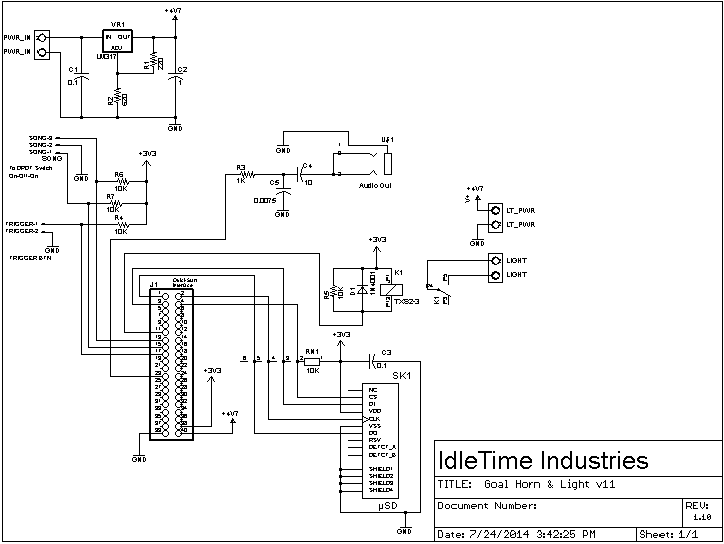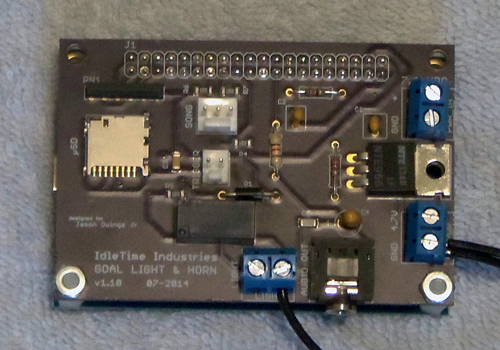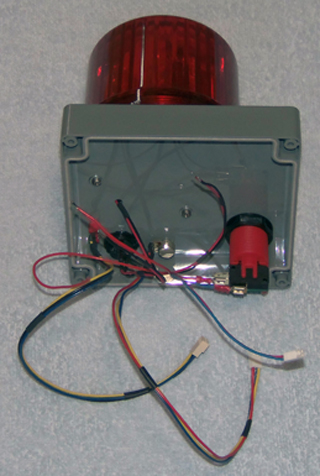Goal Light & Horn
A project based on the Parallax QuickStart board
My 12-year old grandson loves to play hockey, and plays lots of street hockey and knee hockey with his buddies when not on the ice. I found he was using goal horn sound clips off his iPhone and one of my Veho battery-powered speakers to celebrate goals when playing. This project was to provide him with not only his goal horn, but a choice of 3 different sound files that may be triggered, and a flashing red light to provide the full hockey experience!
My original thought was to design a full custom circuit board to provide the ‘brains’, but after further reflection, I decided instead to design a board to plug into one of the many P8X32A QuickStart boards I seem to have accumulated. The plug-in pcb accepts approx 7.4 VDC input from a Parallax Li-ion power pack. The power pack includes 2 18650 li-ion cells (3.7 VDC each) with proper charging circuitry. The custom board powers the QS (QuickStart) by providing approx. 4.7 VDC on the VIN pin (pin 40). The Goal Light & Horn custom board uses the 3.3 VDC returned from the QS regulator (on pin 38) to power the µSD card interface and the relay.
[IMG]http://www.idletime.com/images/Block Diagram.jpg[/IMG]
Onboard the Goal Light & Horn pcb is an LM317 voltage regulator, dropping the battery input to approximately 4.7 VDC. The odd voltage value was chosen due to the voltage requirements on a sticker on the bottom of the red light assembly, although it probably would run off 5 VDC with no problem. This voltage is provided to the QuickStart board on the VIN pin (pin 40). The QuickStart board regulates this voltage to 3.3 VDC and makes that voltage available on pin 38. The 4.7 VDC is also provided to a screw-terminal connection for external wiring to power the audio amplifier and the flashing light assembly.
A µSD socket is powered by the 3.3 VDC and connected to Propeller pins P0-P3. A 10K pull-up is provided on the lines. A DC relay is driven by Propeller pin P10. The relay is a Panasonic DPDT (3V, 16.7 mA) and is driven directly by the Propeller. The line is pulled high via a 10K resistor, as well as the resistance of the relay coil. A screw-terminal connection provides access to a set of Normally Open contacts on the relay; used to activate the flashing light. A 3.5mm stereo audio jack provides the audio stream from the Propeller (pin P20); read from the µSD card. This audio needs further amplification to be of use.

[IMG]http://www.idletime.com/images/v11 PCB.jpg[/IMG]

For the audio amplification, a Sparkfun Mono Audio Amp module is used. This small board utilizes a Texas Instruments TPA2005D1 Audio Power Amp chip. The module has connections for power in, volume control, audio in, and audio out. The TI chip is a 1.4-Watt Class-D power amplifier. It utilizes a PWM-like output, which is clocked at 250 kHz. The speaker effectively ‘filters’ this signal back into audio frequencies. A 4-ohm 2W speaker is in the box, and a 10K logarithmic potentiometer is provided for volume control.
Other external assemblies include a DPDT (on-off-on) toggle switch to select one of three ‘songs’ to be played, a rocker SPST switch for power on-off, and a large, red, arcade-type button to trigger the action. The box itself is heavy-duty plastic.
The software for this project is rather simple. The main program first initializes the WAV-player object (V2-WAV_DACEngine.spin), then enters a loop waiting for the 'Trigger' button to be pressed. The button press is debounced in software. Then the position of the 3-position toggle switch is decoded and used to decide which of 3 WAV files from the µSD card (Song1.wav, Song2.wav, or Song3.wav) is to be played. Along with the WAV file playing, the relay output is switched for 10 seconds, causing the red light to flash for that time.
[IMG]http://www.idletime.com/images/Box Bottom.jpg[/IMG]

[IMG]http://www.idletime.com/images/Goal Light & Horn.jpg[/IMG]
I hope to attach a video soon.
My 12-year old grandson loves to play hockey, and plays lots of street hockey and knee hockey with his buddies when not on the ice. I found he was using goal horn sound clips off his iPhone and one of my Veho battery-powered speakers to celebrate goals when playing. This project was to provide him with not only his goal horn, but a choice of 3 different sound files that may be triggered, and a flashing red light to provide the full hockey experience!
My original thought was to design a full custom circuit board to provide the ‘brains’, but after further reflection, I decided instead to design a board to plug into one of the many P8X32A QuickStart boards I seem to have accumulated. The plug-in pcb accepts approx 7.4 VDC input from a Parallax Li-ion power pack. The power pack includes 2 18650 li-ion cells (3.7 VDC each) with proper charging circuitry. The custom board powers the QS (QuickStart) by providing approx. 4.7 VDC on the VIN pin (pin 40). The Goal Light & Horn custom board uses the 3.3 VDC returned from the QS regulator (on pin 38) to power the µSD card interface and the relay.
[IMG]http://www.idletime.com/images/Block Diagram.jpg[/IMG]
Onboard the Goal Light & Horn pcb is an LM317 voltage regulator, dropping the battery input to approximately 4.7 VDC. The odd voltage value was chosen due to the voltage requirements on a sticker on the bottom of the red light assembly, although it probably would run off 5 VDC with no problem. This voltage is provided to the QuickStart board on the VIN pin (pin 40). The QuickStart board regulates this voltage to 3.3 VDC and makes that voltage available on pin 38. The 4.7 VDC is also provided to a screw-terminal connection for external wiring to power the audio amplifier and the flashing light assembly.
A µSD socket is powered by the 3.3 VDC and connected to Propeller pins P0-P3. A 10K pull-up is provided on the lines. A DC relay is driven by Propeller pin P10. The relay is a Panasonic DPDT (3V, 16.7 mA) and is driven directly by the Propeller. The line is pulled high via a 10K resistor, as well as the resistance of the relay coil. A screw-terminal connection provides access to a set of Normally Open contacts on the relay; used to activate the flashing light. A 3.5mm stereo audio jack provides the audio stream from the Propeller (pin P20); read from the µSD card. This audio needs further amplification to be of use.

[IMG]http://www.idletime.com/images/v11 PCB.jpg[/IMG]

For the audio amplification, a Sparkfun Mono Audio Amp module is used. This small board utilizes a Texas Instruments TPA2005D1 Audio Power Amp chip. The module has connections for power in, volume control, audio in, and audio out. The TI chip is a 1.4-Watt Class-D power amplifier. It utilizes a PWM-like output, which is clocked at 250 kHz. The speaker effectively ‘filters’ this signal back into audio frequencies. A 4-ohm 2W speaker is in the box, and a 10K logarithmic potentiometer is provided for volume control.
Other external assemblies include a DPDT (on-off-on) toggle switch to select one of three ‘songs’ to be played, a rocker SPST switch for power on-off, and a large, red, arcade-type button to trigger the action. The box itself is heavy-duty plastic.
The software for this project is rather simple. The main program first initializes the WAV-player object (V2-WAV_DACEngine.spin), then enters a loop waiting for the 'Trigger' button to be pressed. The button press is debounced in software. Then the position of the 3-position toggle switch is decoded and used to decide which of 3 WAV files from the µSD card (Song1.wav, Song2.wav, or Song3.wav) is to be played. Along with the WAV file playing, the relay output is switched for 10 seconds, causing the red light to flash for that time.
[IMG]http://www.idletime.com/images/Box Bottom.jpg[/IMG]

[IMG]http://www.idletime.com/images/Goal Light & Horn.jpg[/IMG]
I hope to attach a video soon.











Comments
how very cool or as my GS would say "awesome". He and his sister are both avid hocky players so he would like that as well!
Jim